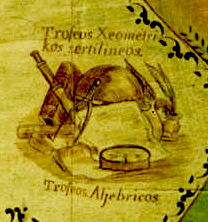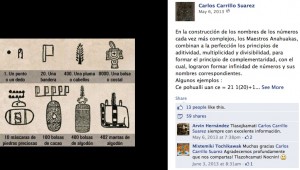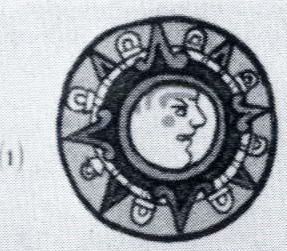On this page we will assemble (with your help!) suggestions for developing curricular materials that might be useful for teaching science, technology, engineering, and math with infused Mesoamerican cultural content.

Algebraic instruments from a late 19th-c. map (falsified) from Puebla. (Photo, S. Wood, Library of Congress, 2010)
Math: Vigesimal System
The root 20, or vigesimal system — in contrast with the Western decimal system — runs across Mesoamerican Cultures. One can reflect with children how both of these systems might have developed (10 fingers, or 20 digits, if we include toes). Note how, in the image below, we see that a single dot, the symbol for the number one, can also be seen in glyphs as one finger, which adds to our theory about counting our human digits. The number twenty is represented by a flag (which can come in various shapes). The number four hundred (20 x 20) is a feather. The number 8,000 is a sack that once may have held 8,000 cacao beans or pieces of incense. The bottom row in the image below shows us how number glyphs were combined with iconography representing very common items of preciosity and tributes, such as masks made of precious stones, larger sacks of cacao beans, sacks of cotton, and bolds of cotton cloth or cloaks. Notices that the number 100 (bags of cacao) is represented by five flags, i.e. 5 x 20. The 402 cotton cloaks shows the folded cloak and, above it, to fingers (2) and one feather (400). This kind of material can provide fun math projects for children.

Some Nahua counting glyphs (a screenshot of a message posted to Facebook by Carlos Carrillo Suárez, 2013)
One can also explore how this system is reflected in the calendars that Mesoamericans developed. Mesolore hosts a video where Anthony Aveni speaks about “Mesoamerican Mathematics,” including a discussion about gestures and writing, living numbers, numbers and time, Vigesimal versus Decimal, Base-Twenty Notation Numbers in History, the Maya Books, Venus and Mathematics, the Heliacal Rise, Carting Venus, the Number Zero, the Number 584, and Astrology.
Here are some additional resources:
- “Base 20 Mathematical System in Mesoamerica,” Facts on File
- “Mesoamerican Concept of Zero,” Facts on File
- Vigesimal system web page
- “Abacus in Mesoamerica,” really about the Aztec nepohualli, counting device, Facts on File
- “The Discovery of Mesoamerican Culture with Math,” by teacher Melinda López (Houston, 2007)
- Stephanie Wood’s Nahua Counting Exercise using a codex page
- Mesoamerican calendrics, inter-related wheels (image)
- Nahuatl Dictionary: insert the word “twenty” and or “vigesimal” in the search box and scroll through the results
Math: Geometry
Here is a link to a PowerPoint presentation by Stephanie Wood about pyramids and geometrical shapes, angles, vocabulary, and more, as an initial effort in imagining what might be taught about math using Oaxacan indigenous cultures or Spanish colonial culture as a starting point. We welcome the input and improvements by math teachers!

Sun symbol. Search tonatiuh in the Nahuatl Dictionary. Florentine Codex (public domain)

The tail of a comet. Search pocyotl in the Nahuatl Dictionary. Image from the Florentine Codex (public domain)
Astronomy
Many pre-Columbian settlements were laid out in alignment with the movement of the sun, and the solstice was especially notable. The importance of astronomy to indigenous Americans is more and more obvious as scholars take a closer look at settlement patterns. If this topic interests you, be sure to ask our resident archaeologist to refer to alignments when we are in the field.
- “What Was the Symbolism of the Four Directions?” Julia Flood, Mexicolore
- Here’s another quincunx at Mexicolore
- “Astronomy in Ancient Mesoamerica,” by Ivan Sprajc, Journal of Cosmology (2010)
- “Astronomical Alignments in Teotihuacan,” by Ivan Sprajc, Latin American Antiquity (2000)
- “Astronomical Alignments Were Vital in Mesoamerica,” Past Horizons: Adventures in Archaeology (2013)
- “The Cross Petroglyph: An Ancient Mesoamerican Astronomical and Calendrical Symbol,” by Anthony F. Aveni and Horst Hartung (a related search term or keyword for further research is “quincunx”)
- On this page (Figure 4) you will find a fascinating collection of symbols of the quincunx from Mesoamerica
- This collection of Maya glyphs includes several that have the symmetrical arrangement (notice, especially, Lamat and Etz’nab)
- Diagram of a quincunx shape on a mural at Teotihuacan
- See this comparison of the quadripartite organization of the universe in the Mesoamerican and “Western” imaginaries
- Quincunx in the Patolli game (image)
- Below, notice the division of Tenochtitlan into four parts with an X-shaped arrangement
Ethnobiology
In this institute we will have more content relevant for developing ethnobiology units than any other STEM curricula, which has prompted us to prepare a number of sub-pages on this topic. We are open to expanding these possibilities. But we also hope you will also suggest additional STEM projects that strike you as possible given the institute foci.
Here is a Mesolore interview with Alejandro de Avila, of Oaxaca, speaking about ethnobiology and ecology (go a bit more than 2 minutes into this video to here what he says about the subject). This video is in Spanish with English subtitles. This person has been involved in the creation of the ethnobotanical garden and serves as its director. He was also instrumental in developing the textile museum.
Another Mesolore interview, with Ellen Messer, includes a discussion of the science of maize and its transformation into food, as it was prepared with limestone. This interview is in English with Spanish subtitles. Go to the point at about 4:40 minutes to hear her scientific explanations. She also speaks about chilies and chocolate and their roles in the Mesoamerican diet, including nutrition, taste, and digestion.
A third Mesolore interview that is relevant for ethnobiology, with Julieta Ramos-Elorduy, discusses edible insects in their various life stages, the use of bugs for their medicinal value, and their role in feeding on waste and converting themselves into a protein for feeding animals, such as chickens. Scientists are measuring the effect these waste-eating insects can have on animal growth, reproduction, and coloring (yolk, feet, beak, and meat).
Here are some pages we have begun to develop, relating to ethnobiology:
- Animals & Birds
- Maize/Corn
- Cacao/Chocolate
- Cacti & Cochineal
- Grasshoppers
- Axayacatl Bugs
- Worms
- Turkeys
- Meso Medicine
Technology
We would love some suggestions about ways of teaching technology by using Oaxacan indigenous and Spanish cultures as a launching pad. Some areas where we have photographic stills and moving images are:
- Candle Making (introduced by Europeans)
- see image from the Florentine Codex of candle making
- do a search of “candela” (a loanword in Nahuatl) in the Nahuatl Dictionary
- Chocolate Making
- pre-Columbian grinding stones and post-contact chocolate mills
- pre-Columbian and post-contact frothing implements
- Healthcare (bathing, medicine-making, etc.)
- Lithic technologies
- Crystal Skulls
- Not one crystal skull found in a museum today was found in an archaeological dig, and all are fakes, according to Jane Walsh of the Smithsonian
- See also “Legend of the Crystal Skulls“
- “Crystal Skulls History“
- Stones Carved without Steel Tools
- “Aztec Stone Sculpture,” Metropolitan Museum of Art, with slide show and brief explanation of how stone was carved so intricately without steel tools
- Obsidian
- Map of Mesoamerican obsidian sources, jade, and cinnabar mining
- “Obsidian Use in Mesoamerica,” in Wikipedia
- Elaborately carved obsidian, Classic Maya (image); and another
- Sacrificial knife (Mixteca Alta), ca. 1200–1500, with large obsidian blade and turquoise mosaic handle (image)
- black prismatic obsidian blades from West Mexico found in Calixtlahuaca (image)
- green prismatic obsidian blades from Central America (image)
- Maya, Central American obsidian sources, trade, technology (website and images)
- gray prismatic obsidian blades from Pachuca, found in Coixtlahuaca (article and images)
- greenish prismatic obsidian blade from Pachuca found in the ocean (from a shipwreck?)
- Keep your eyes open for prismatic blades (or pieces thereof) on our archaeological excursions and in museums
- Jade
- “Jade in Mesoamerica,” Metropolitan Museum of Art
- “Mesoamerican Jade“
- “The Origins of Mesoamerican Jade“
- “Jade Use in Mesoamerica,” in Wikipedia
- 6th-10th c. jade mask of the Olmecs (image); elaborate jade carving from the Petén (image)
- Cinnabar
- “Cinnabar,” in Wikipedia
- “Cinnabar Use in Ancient Mesoamerica,” Facts on File
- Red decorations on architecture and art objects can be cinnabar, as we see on this Maya cup (image), this Zapotec effigy vessel, and this Teotihuacan pyramid recreation
- See also the book by Kenn Hirth, Mesoamerican lithic technology: experimentation and interpretation. Salt Lake City: University of Utah Press, 2003.
- Crystal Skulls
- Paper making (amatl, amate)
- An explanation of how amate is made (see page 310)
- Traditional Paper Making and Paper Cult Figures of Mexico (full text book reproduction, Internet Archive)
- “The Endurance of Mexican Amate Paper,” Rosaura Citlalli López Binnquist, Ph.D. Dissertation, full text, open-source, 2003
- Pulque and Mezcal Production
- fermentation vs. distillation
- “Pulque: A Mexican Indigenous Brew” (not distilled)
- “What is Pulque?” (not distilled)
- “The Process for Making Mezcal” (About.com) (distilled)
- Five-minute mezcal-making video (distilled)
- “Making Mezcal” (includes a video) (Mezcalistas.com)
-
Rubber making
- “A Good Many Years before Goodyear,” MIT News (2010)
- see rubber balls used in the ball game
- search the words olli and rubber in the free online Nahuatl Dictionary
- Textiles
- pre-Columbian backstrap looms and post-contact looms (see image of backstrap loom below)
- pre-Columbian spindles and post-contact spinning technology
- natural, pre-Columbian dyes and post-contact methods
- Tobacco (smoked prior to contact)
- search the word picietl in the Nahuatl Dictionary
- “Fancy a Puff?” Mexicolore article
- “Tobacco History“
- “Tobacco,” Oxford Reference
- “Tobacco, Mesoamerica,” Facts on File
- Smoking Monkey Man, Late-Classic Maya vase image
- Early image of a European man using a tobacco pipe
- Weaponry
- Aztec weaponry, in general
- the maquahuitl/macuahuitl (or macana, in Spanish), the obsidian-studded club
- image of a macana
- Florentine Codex image of macanas in use
- Writing and Painting, pre- and post-contact
- Image of a rolling stamp print
- See this online article about “Pre-Columbian Rolling Stamp Seals and Roller Seals“
Wikipedia
Wikipedia offers a page with links to Science and Technology of Mesoamerica
IAGO Library
The free library at the Instituto de Artes Gráficos de Oaxaca, on Macedonio Alcalá, has some books that might be useful for STEM projects. See, for example, the book below…




